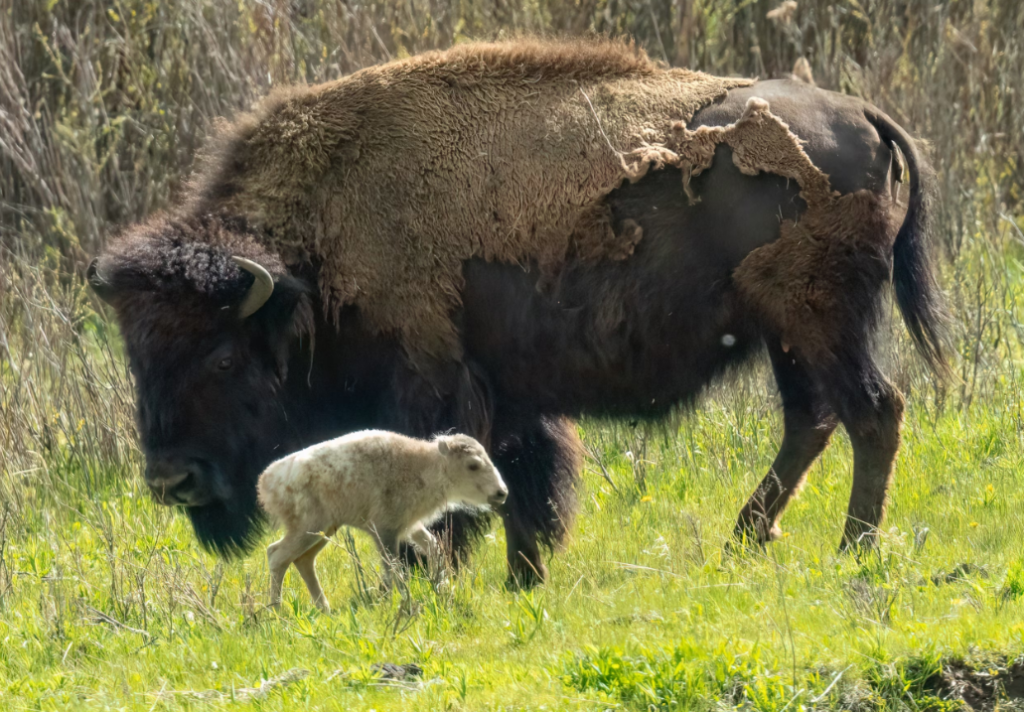
It’s not often that the birth of a wild animal causes a stir among so many different groups of people, but a white American bison calf photographed in Wyoming has done just that.
“We’re in Yellowstone this week and just missed this birth by a few minutes!” wrote photographer Erin Braaten in a Facebook post on June 4. “A white bison calf!!” News of the birth quickly spread around the world after that.
Images of albino, yellow, or blonde animals—from giraffes, tapirs, and monkeys to cougars, badgers, and frogs and snakes—often fascinate the public. But this pale bison, also known as an American buffalo, has special significance in Indigenous cultures.
“There are prophecies about white buffalo calves being born at a time of great change,” says Jason Baldes, a member of the Eastern Shoshone tribe and executive director of the Wind River Tribal Buffalo Initiative. “We have stories of the Eastern Shoshone people hunting and pursuing white bison or white buffalo from well over a century ago.”
Buffalo used to roam from Alaska to Mexico and number between 30 to 60 million. Although that population was driven down to just 325 animals by 1884, scientists and conservationists have since rescued bison from the brink of extinction. But most of the 30,000 buffalo that exist today aren’t as free or as wild as you might think.
“With the momentum that we see with bison restoration and conservation, I think this will help to bring awareness about the importance of, not only the sacredness of that white buffalo calf, but also the issue of [buffalo] existing as wildlife,” says Baldes, who is also a National Geographic Explorer.
What is a white buffalo—and how rare is it?
While studies about the frequency of albinism or leucism have taken place in animals such as penguins, white buffalo are much less studied.
One statistic bandied about online, and misattributed to the National Bison Association, is that a white buffalo calf will occur in one out of every 10 million births.
“To my knowledge, no one has kept consistent records of white buffalo being born,” says Jim Matheson, executive director of the National Bison Association. “Therefore it’s tough to make a determination of occurrence.”
At least anecdotally speaking, there haven’t been many in the last few decades, says Robert Pickering, author of Seeing the White Buffalo. Most of the white bison you do hear about actually come from cross-breeding bison and white Charolais cattle.
“There’s a lot of private producers, folks that are in the bison industry, that realize that there’s a lot of attention garnered from white bison calves,” says Baldes. “And that really is not a good thing in terms of conservation for bison.”
Matheson and the National Bison Association agree. “Our code of ethics would forbid that type of cross breeding,” he says.
The other, less common ways you can get a white bison would be examples of albinism or leucism, genetic conditions that affect pigmentation. Bison with albinism would have pink eyes, hooves, and noses, while leucistic animals lack pigment in some but not all of their tissues.
Pickering’s book catalogued another instance of the latter in Wisconsin in 1994. Named Miracle, that buffalo was born with white fur, but black eyes, hooves, and nose. It’s the animals with these leucistic features that appear across many Native American cultures, from the Sioux to the Cherokee.
The new calf appears to be of that same sacred variety, says Pickering.
“Now, the interesting part about Miracle, and we’ll see if it’s going to be true about this new calf,” says Pickering, “although it was born with a white pelage, Miracle turned nearly black when she got her winter coat.”
Even more curious, as the seasons changed, Miracle next turned reddish and then yellowish.
“Red, yellow, black and white are the four sacred Lakota colors,” Pickering says. “So in a sense, that verified that she was a spiritual being.”
‘A blessing and a warning’
“The birth of this calf is both a blessing and warning,” Chief Arvol Looking Horse, the spiritual leader of the Lakota, Dakota and the Nakota Oyate in South Dakota, told the Associated Press.
“We must do more,” says Looking Horse, who is the 19th keeper of the White Buffalo Calf Woman Pipe and Bundle, a sacred artifact to his people.
As senior buffalo program manager through the National Wildlife Federation’s Tribal Partnerships Program and vice president to the InterTribal Buffalo Council, Baldes has been working to restore bison to tribes that want to have them.
“We, the Eastern Shoshone, call ourselves the Buffalo Eaters, the Gweechoondeka, even though they were missing from our diet for well over 130 years,” says Baldes.
“Most buffalo exists today in private herds and ranches,” he says. “They are essentially ecologically extinct.”
One way to remedy this is to buy land and release bison onto it. So far, the InterTribal Buffalo Council has managed to acquire 25,000 wild bison across 65 herds held on tribal land. More recently, at Wind River, Baldes helped get approval to convert 17,000 acres of cattle pasture into bison habitat.
“The limitation, often-times for tribes, is land,” he says.
Restoring bison to the landscape is of the utmost importance, he argues—and not only for the ancient eco-cultural importance that this species holds for Native American tribes.
“They increase plant and animal biodiversity. That should be reason enough,” says Baldes.
